

Ben Zachariah
Video: Off-road battle for Beer O’Clock Hill has automakers scrambling
7 Hours Ago
After an 18-month hiatus Audi’s compact four-door RennSport pocket rocket is back in Australia – now with more carbon-fibre.
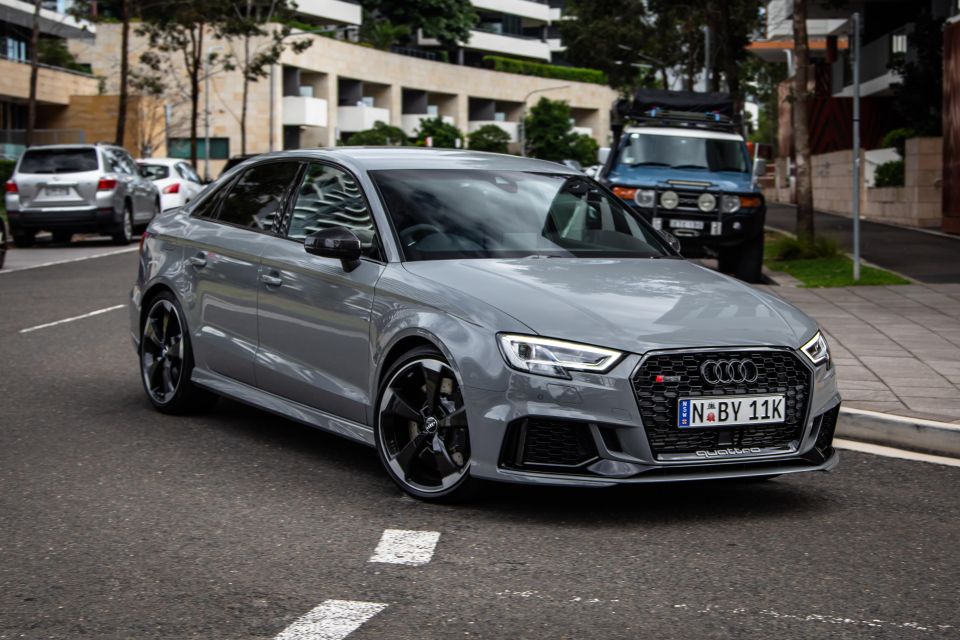
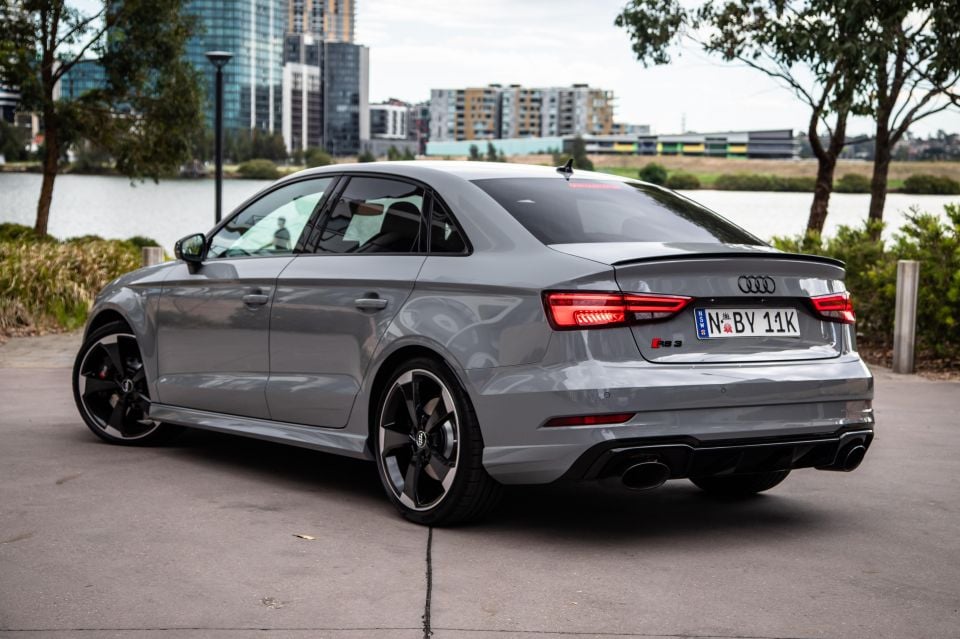

Journalist
New from
$89,900
excl. on-roads

Journalist
New from
$89,900
excl. on-roads


Journalist
New from
$89,900
excl. on-roads

Journalist
New from
$89,900
excl. on-roads
Quickly see how this car stacks up against its competition. Select any benchmark to see more details.
Where expert car reviews meet expert car buying – CarExpert gives you trusted advice, personalised service and real savings on your next new car.
Audi’s popular RS3 small hatch and sedan range has returned to local terra firma after being sidelined with world harmonised light vehicle testing procedure (WTLP) certification.
Originally slated for late-2019 release, the cleaner and more lavishly appointed breed also wants for richer money, and given next-gen prototypes have been spied and its milder S3 brethren have broken cover, the current matured version has lobbed just in the nick of time.
This ‘new’ RS3 should look familiar: its gen-three roots date back to 2012 and the current facelifted version launched locally in 2018 only for production to be yanked late that year due to WTLP. Its fashionably late return to the party sees the addition of a petrol particulate filter (PPF) fitted to slip through the WTLP auspices with Audi promising no dilution of the dynamite RS3 lovers pay a pretty penny or three for.
Of the four versions available right now, our test car is the RS3 Sedan Carbon Edition, something of a range-topper given it’s the priciest of the quartet. And yours truly reckons this final update of its generation makes for the sweetest and most well-rounded extension of the RS3 concept yet.

The RS3 Sedan Carbon Edition lobs for $89,900 before on-road costs.
Opting for the higher-grade Carbon Edition adds $3400 to regular ‘non-carbonised’ RS3 Sedan ($86,500). Choosing the four-door body style adds $2700 over the equivalent five-door RS3 Sportback ($83,800) and RS3 Sportback Carbon Edition ($87,200 list) versions.
Essentially, pricing has risen a few grand during the range’s two-year Aussie market hiatus.
Our test car, though, fits an RS design package that, at $1950, lifts the as-tested price to a frosty $91,850 before on-roads and adds a smattering of goodies such as red-edged seat belts, black and red air vents, red stitched ‘mono.pur’ armrests, RS3 logo mats and Alcantara knee pads on the centre console. Nice if hardly essential extras targeting those completest owners.
The RS3 range is available in seven solid, metallic, pearl and ‘prestige’ (lime Kyalami Green) colours at no extra cost, or in two crystal effect hues wanting an extra $728 each.
MORE: Audi RS3 pricing and specs

Buy your new car without the stress. It's fast, simple and completely free.

Great service from Travis and team, second time I have used this business would not hesitate to recommend them to anyone
Craig C.
Purchased a Ford Ranger in Sunshine Coast, QLD
CarExpert helped Craig save thousands on his Ford Ranger, now let us save you on your next new car.
Find a dealThe price rise brings with it a few extra goodies over the old pre-WLTP version that went off-market in 2018, including electro-magnetic adaptive suspension damping, Bang & Olufsen sound, inductive phone charging and the aforementioned standard paint upgrade.
The last time I reviewed an RS3, the 2016 Sportback, I hammered the thing for lacking adaptive dampers for its considerable ask, so its standard inclusion in MY20 form is, in this reviewer’s opinion, a significant amendment in spec.
Of course, buyers are in it for performance and dynamics, so the key features are its iconic 2.5-litre five-cylinder engine, RS-certified powertrain, big eight-piston front brakes, distinctive exterior styling and boy/girl-racer interior fit out and infamous chassis ‘tune’ that, in Carbon Edition form, mandates that the (255/30) front tyres are two centimetres wider than the (235/35) rear. The regular non-Carbon RS3, though, fits 235s all round.
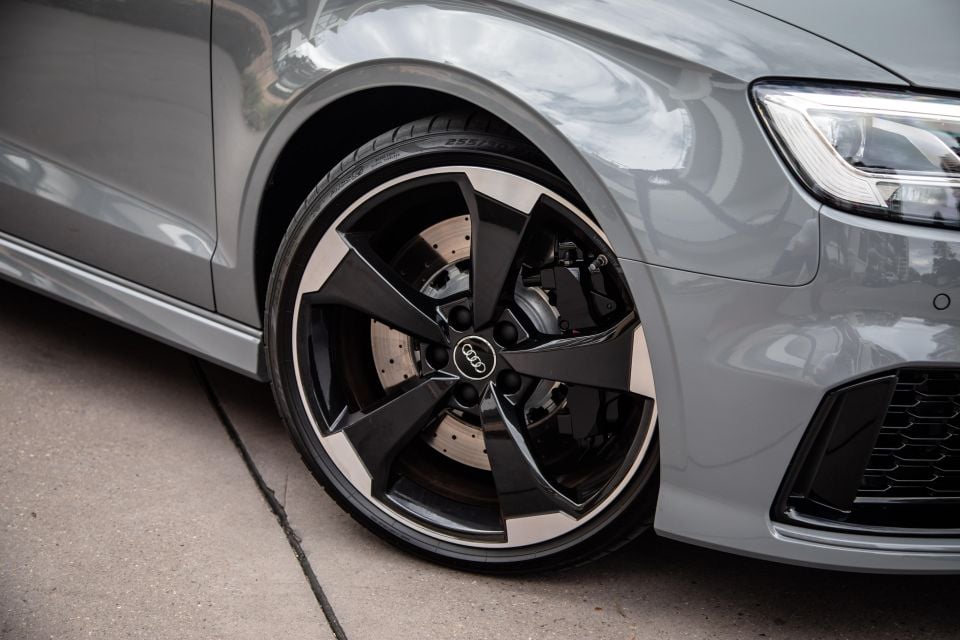
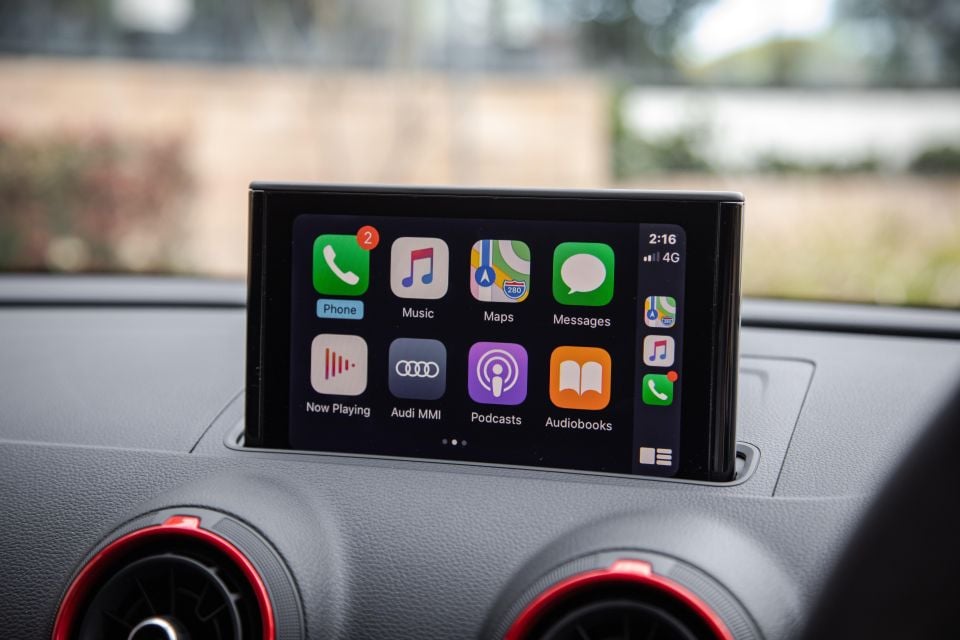

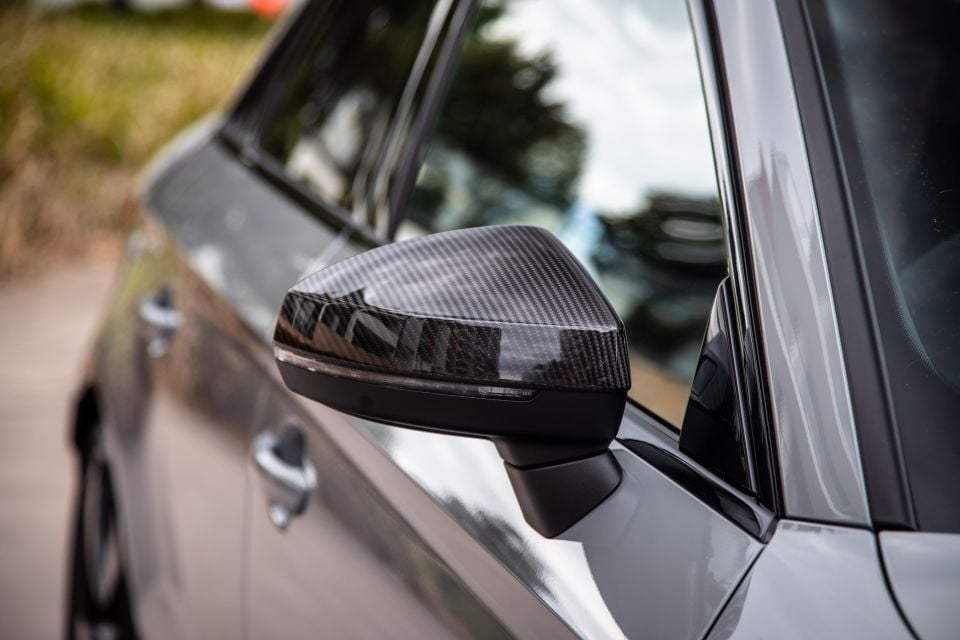
Outside, the RS3 Carbon Edition fits the aforementioned staggered rubber, gloss anthracite black 19-inch rims, full LED lighting, dynamic indicators, heated/power-folding mirrors with carbon-fibre caps, rain-sensing wipers, front and rear parking sensors, black badges, specific exterior and interior trim highlights, privacy glass and a panoramic roof (which can be delete-optioned).
Inside, standard features include RS-specific seating with quilt-stitched Nappa leather trim and heating, a flat-bottom steering wheel with paddle shifters, keyless go, 12.3-inch Virtual Cockpit digital instrumentation, carbon twill inlays, an auto dimming mirror, dual-zone climate control and LED ambient lighting.
Its ageing 7.0-inch MMI navigation plus system with console controller has been modernised somewhat with the inclusion of Apple and Android smartphone mirroring, Audi connect WiFi hotspot and Google services, DAB+ and proprietary sat-nav.
Adaptive cruise control with traffic jam assist, Audi parking assistance plus with reversing camera and tyre pressure monitoring are also on the standard features list.

Euro NCAP tested a left-hook A3 hatchback back in 2013 and it forms the basis for ANCAP’s five-star ratings for “all Australasian variants” from 2013 model-year onwards. RS3 arrived in 2015, post testing, so interpret this assessment as you will.
For the record, A3 scored 15.41 out of 16 for frontal offset crash, a full 16 out of 16 for side impact and 2 from 2 for pole testing. Whiplash and pedestrian protection rated ‘good’ and ‘acceptable’ respectively for an impressive overall score of 36.41 out of 37 in what’s now a defunct pre-AEB testing regime.
Still, the RS3 looks certifiably fit in equipment by 2020 safety expectations. Its autonomous emergency braking system is all-speed and technically paired with adaptive cruise control, while also fitting seven airbags (including driver’s knee), blind-spot monitoring and vehicle approach warning (aka side assist), active lane keeping, rear cross-traffic alert and hill start assist. Good all-round coverage, then.
It would be remiss to not mention the particularly powerful 370mm eight-piston front and 310mm single-piston rear brakes – anchors are, of course, a vehicle’s primary safety system.
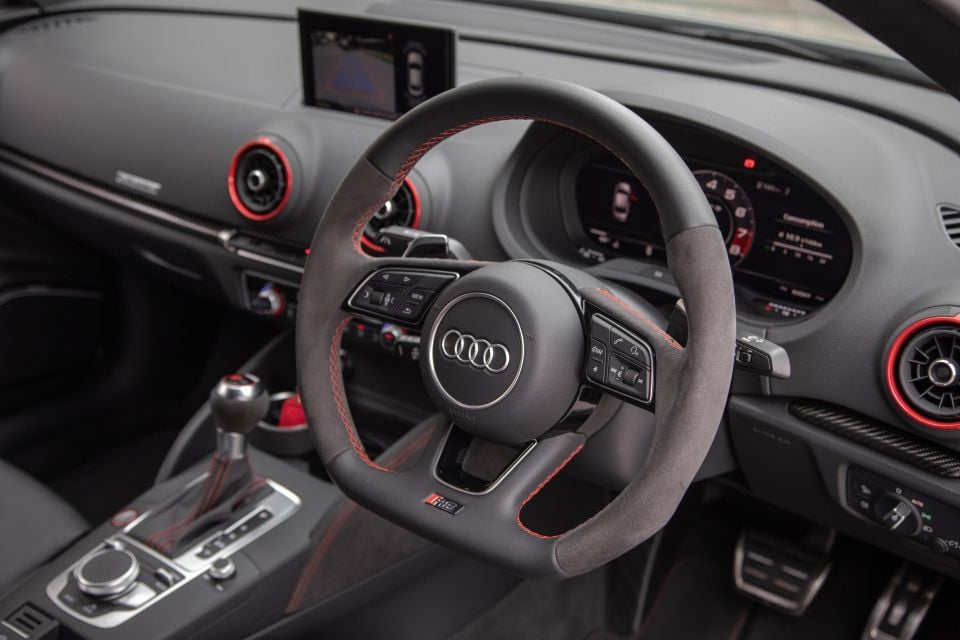
Most RS3 owners are primarily in it for performance as a priority and given this generation’s age some concessions will have to be made in the cabin. Audi’s done a decent job sprucing it up to the nines but there are some areas that are conspicuously dated – the list of slicker and more contemporary Audi model interior designs these days form a fairly lengthy line.
The design package-enhanced RS makeover does build handsomely upon humble A3 foundations. The diamond-patterned Nappa leather, lashings of red stitching, neat half Alcantara-wrapped flat-bottomed wheel and generous splashes of alloy, carbon twill, red anodised-look highlights and the neat white LED feature lighting that form outlines across various details and surfaces really bring a lot of go-fast celebration. Even the plush-pile RS mats are tasty.
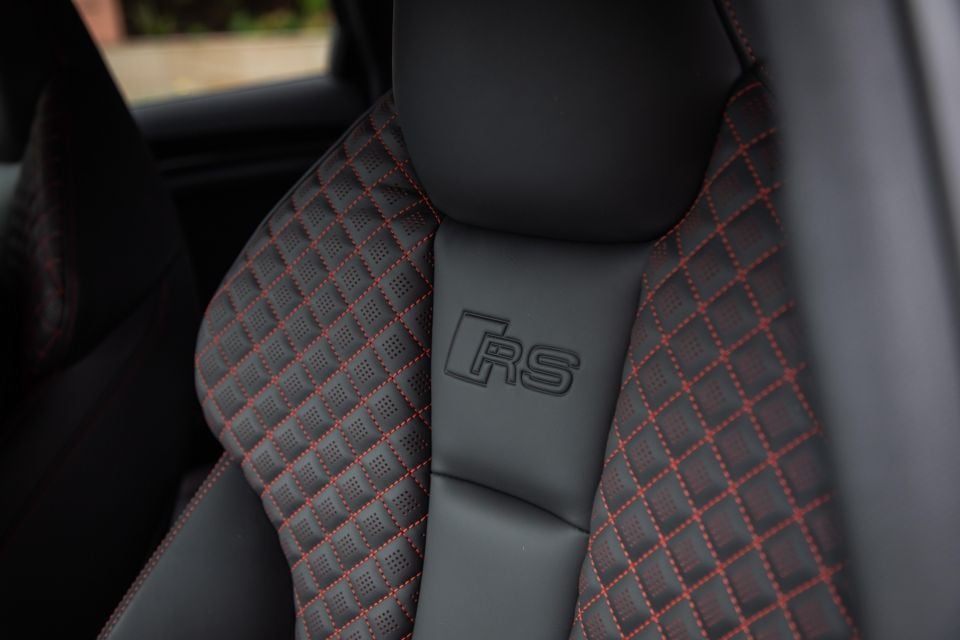
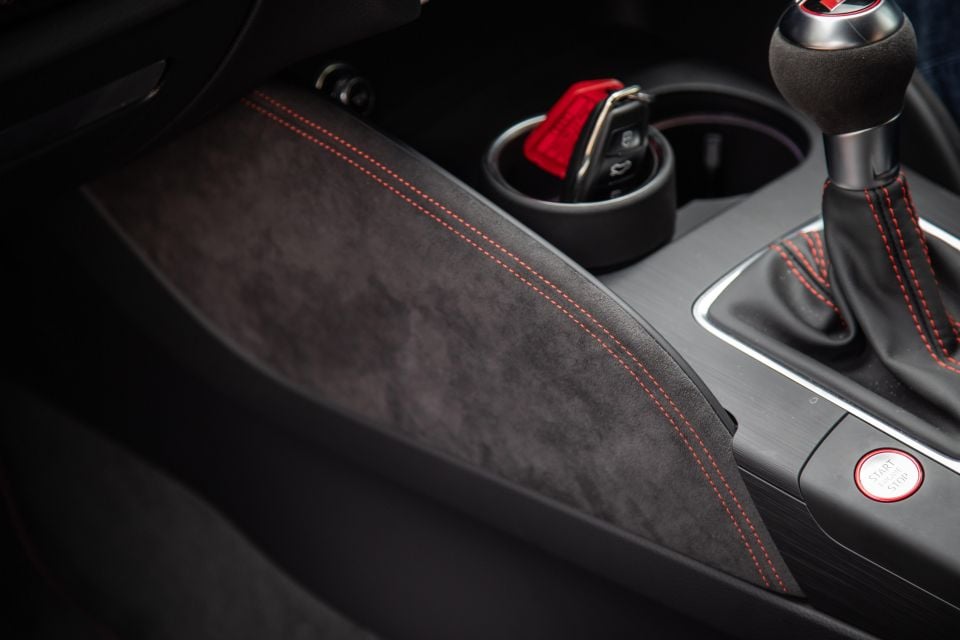
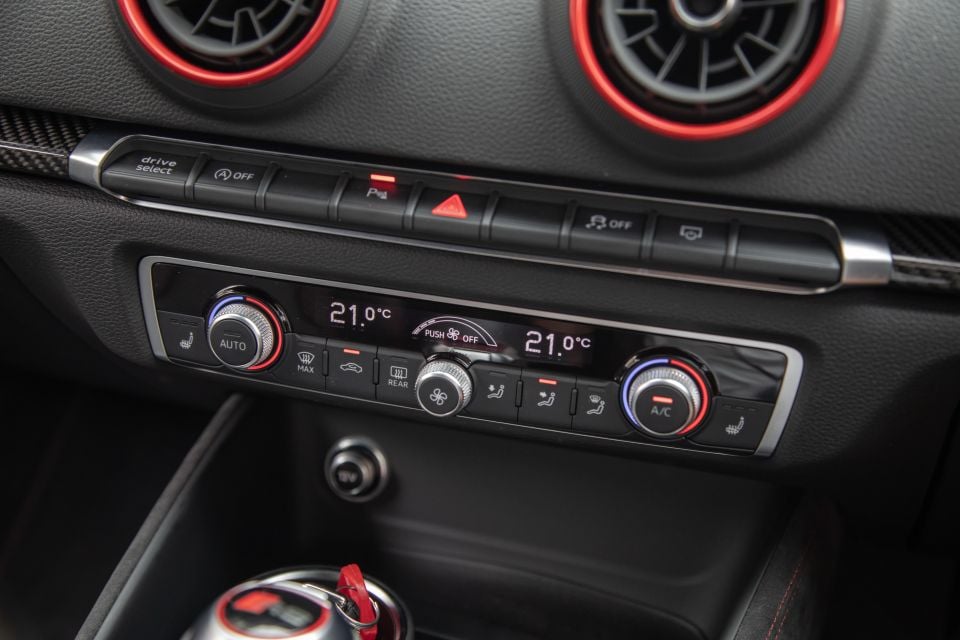
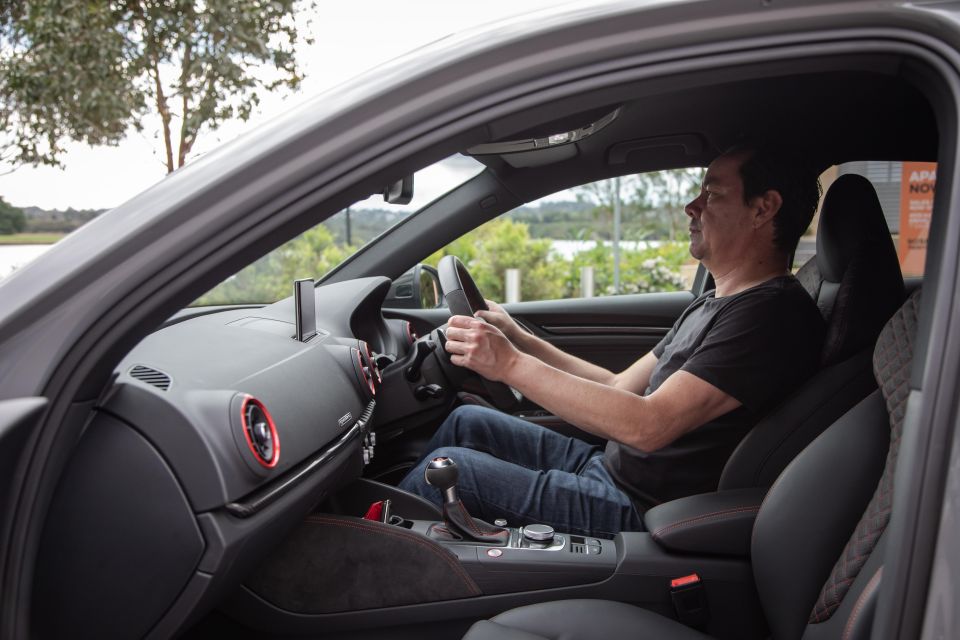
The Virtual Cockpit has the older RS skin format and presents well but isn’t as sharp as newer displays. The downright tiny 7.0-inch infotainment screen – a non-touch design in an era when Audi has now all but abandoned its MMI touch controller format – is almost retro in look and functionality yet still packs in enough content needs.
A good mate and former RS3 owner swears the seats are “the most uncomfortable ever fitted to any car” but I found our test car’s pews pretty decent, with reasonable padding give and contours relaxed enough to avoid long-haul pain. The mechanical adjustment is traditional RS schtick though lumbar is electric.
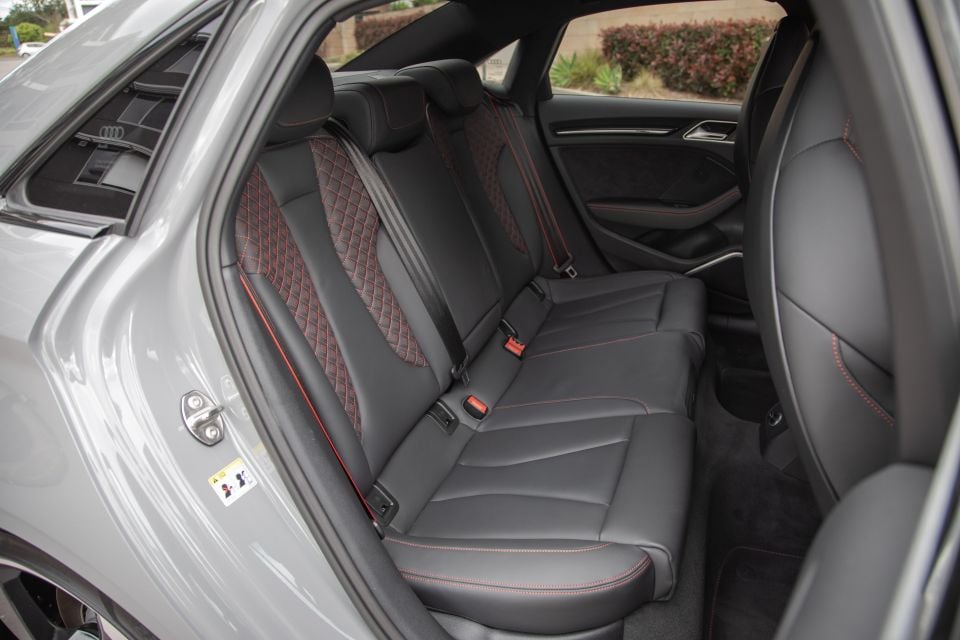
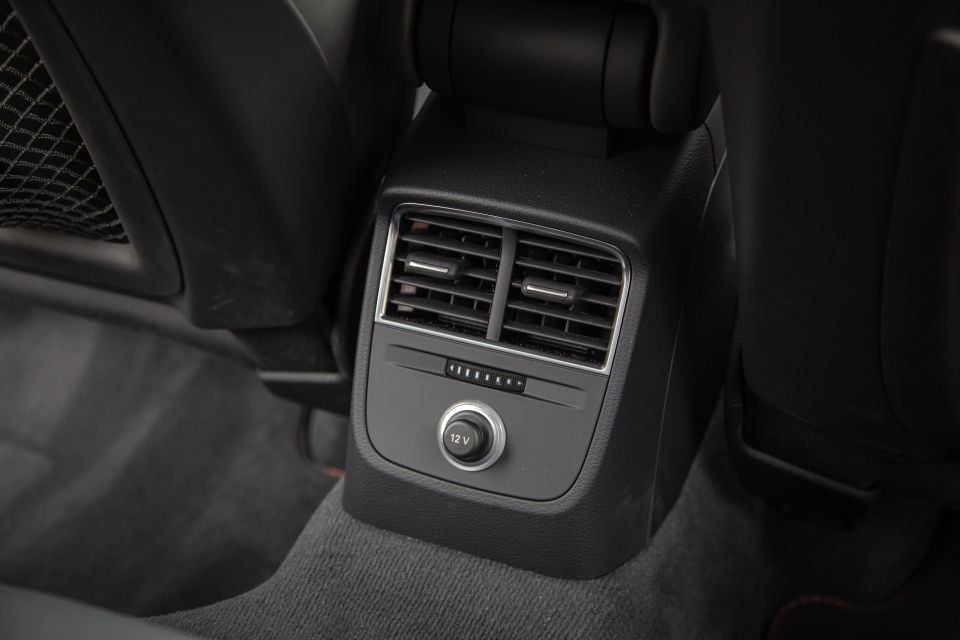
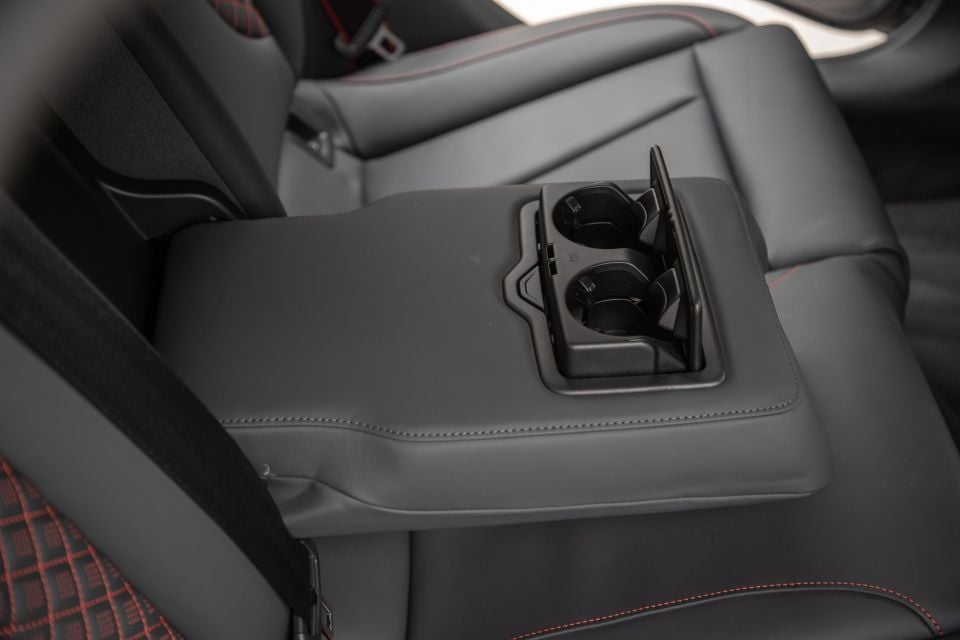
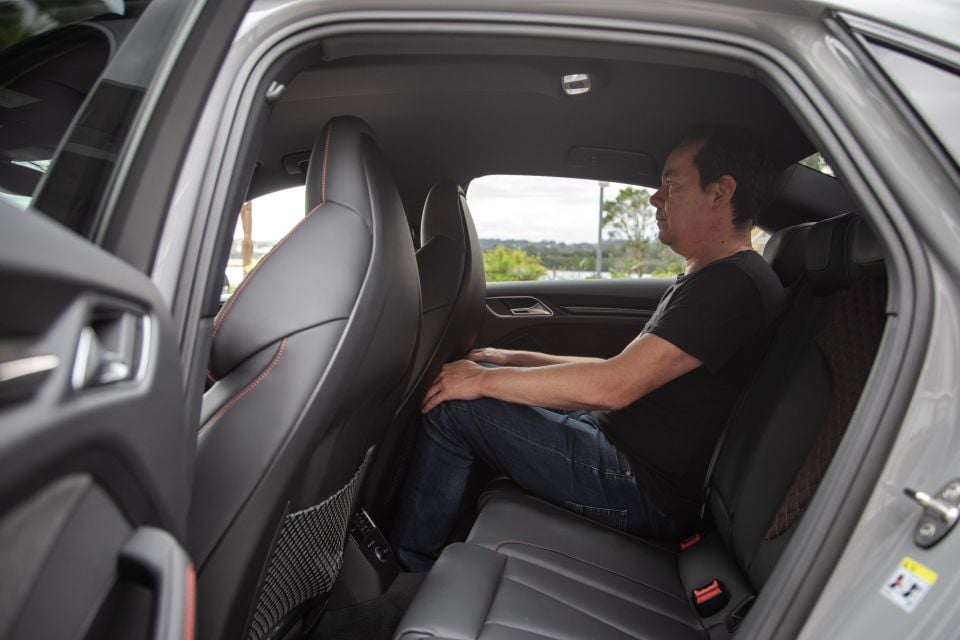
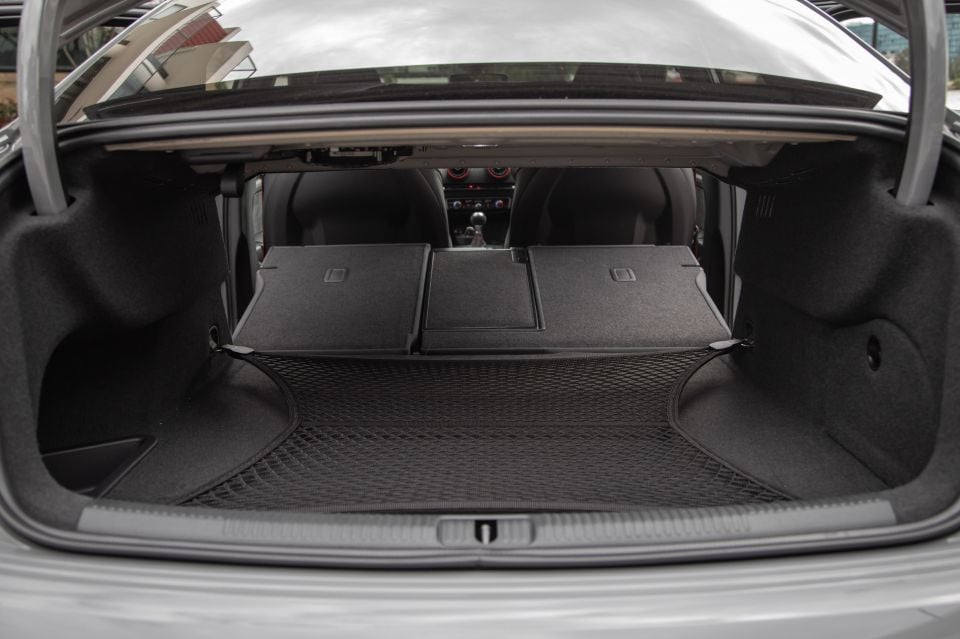
Bar some limited headroom, rear spaciousness is decent enough for two adults, a pronounced hump in middle position of the seat back realistically making it fit for emergency use only. Rear air vents and a sole 12-volt outlet feature in the back of the console.
Boot space is a decent 350 litres expanding to an equally-acceptable 770L with the rear seats folded but, frankly, if more practical load-lugging dimensions are your thing you’d already focused your shopping in the direction of the Sportback hatch, with far less restriction between boot and cabin.
The sedan, then, is arguably a more mature format – even if merely by measure of appearance and vibe – and in all practicalities it’s utilitarian enough by small four-door measures.
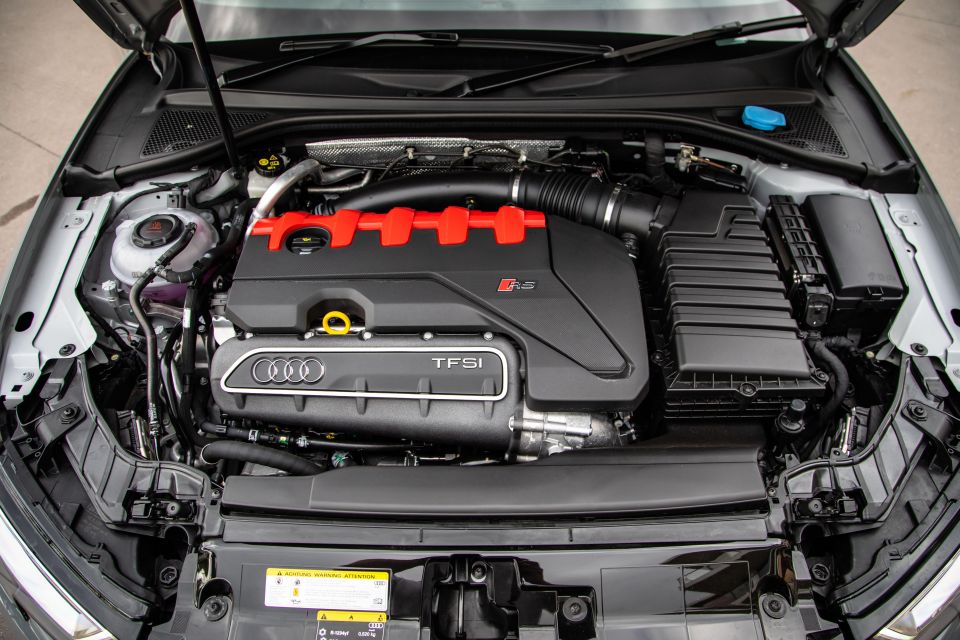
Five turbocharged cylinders almost nudging 300kW at full noise are possibly the primary list-topper of reasons why this giant-killer is in your shopping cross-hairs.
More than just a mechanical homage to Ur-Quattro glory days, the 2.5’s cylinder count alone makes RS3 genuinely unique in the company of four-pot rivals and no specific output boasting from the AMG camp detracts form just how special the Audi’s inimitable heartbeat is.
The engine was heavily revised for 2017’s facelift and at 294kW at 7000rpm and with 480Nm from just 1950rpm. The subsequent and more recent WTLP tweaks last year haven’t seemed to have dampened this unit’s prowess in outright terms though whether the new emissions changes affect driveability and sonics – both high water marks for the breed – will play out on road.
Performance is a claimed 4.1 seconds for the run to triple figures, hair-raisingly quick and no slower in this emissions-friendlier tune, with drive channelled through a seven-speed dual-clutch transmission and RS-spec quattro all-wheel system.
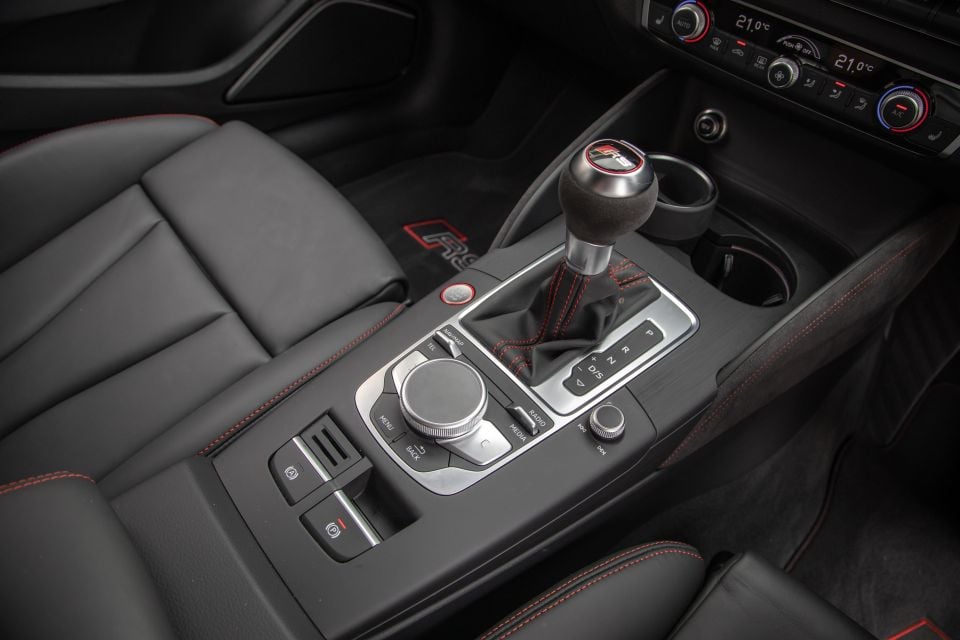
An electro-multi-plate clutch in this transverse architecture is said to be capable of shuffling most torque rearward for optimum driving pleasure though, given it’s mounted at the rear axle, it’s akin to black magic engineering (I’ve spent a few hours with RS engineers overseas attempting to explain to me just how the front axle could harbour less than 50 per cent of torque in Audi’s transverse layout).
Also nigh on miraculous is combined consumption of a claimed 8.5L/100km for any combustion engine producing almost 300kW. Given my highway stint of testing of returned low sevens and occasional drops into the sixes, it’s certainly plausible.
Of course, thirst climbs dramatically in tandem with right foot enthusiasm – call it 11s for mostly urban driving on test – but it’s lean when it wants to be even if, I fear, this glorious unit’s days are numbered with Europe’s ever-tightening emissions legislation.
The traditional eight-pot brakes, newfound and most welcome adaptive damping, bizarre tyre width stagger all conspire to create an RS3 match fit for the performance premier league, and justifiably so for its lofty price.
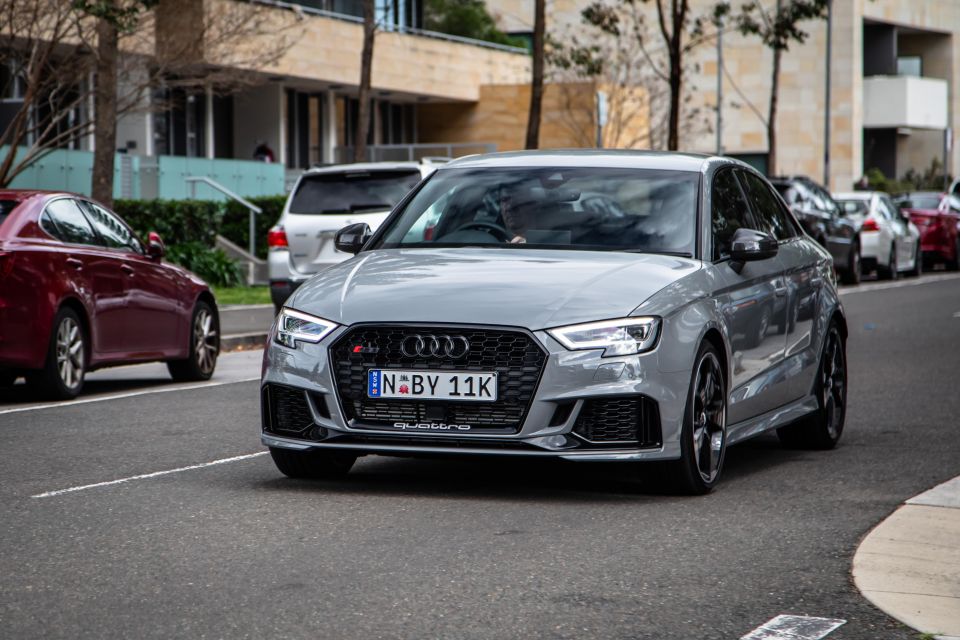
It drives tangibly nicer and better than the last one (2017 Sportback) I drove. And hasn’t taken much alteration to yield a nicer experience.
I lambasted the old test car for its punishing ride. It was nigh on unliveable and frankly, passive damping in a $90,000 small car is a piss-take. The post-facelift MY17-onward gear not only amends the equipment list the tune chosen for Comfort is excellent – compliant in primary ride, if a touch rigid across the rear over speed humps, while taut and polished enough to barely rob the chassis of its impressive dynamic prowess.
Most important, though, is performance. Predictably, in Dynamic mode it lunges for the horizon with breathtaking vigour though it could be a touch less violent than pre-WTLP versions at initial kick-down. Maybe. We’re taking shades here and it’s tough to say for sure, but there’s a sense that in perhaps improving low-rpm emissions the ramp up to full noise is slightly blunter.
This, for me, is a good thing. Why? Because the low-speed throttle response is very user-friendly. You can drive it around town in Dynamic without too much histrionics though, pleasingly, the five-banger is so flexible the sedan is still impressively swift, response and flexible in Auto or Comfort modes. Given it’s a cleaner engine, call it a win-win.
Sonically, it doesn’t seem to roar and crackle quite like I remember the RS3 once did. Indeed, I happened to come across a white stock pre-facelift Sportback in traffic and its metallic bark seemed a few decibels bolder than grey sedan I was sat in. Again, a change in shades perhaps. Possibly.
Gear-heads find sport in bemoaning performance Audi steering ‘feel’ – I find it actually quite good in that it’s direct, evenly measured, confidently connected and offers reasonable feedback when you lean on its nose into a corner. The dual-clutch, too, has a similar clean and crisp vibe with a nice seamlessness on the move and just a hint of clutch take-up palpitation at parking speeds.
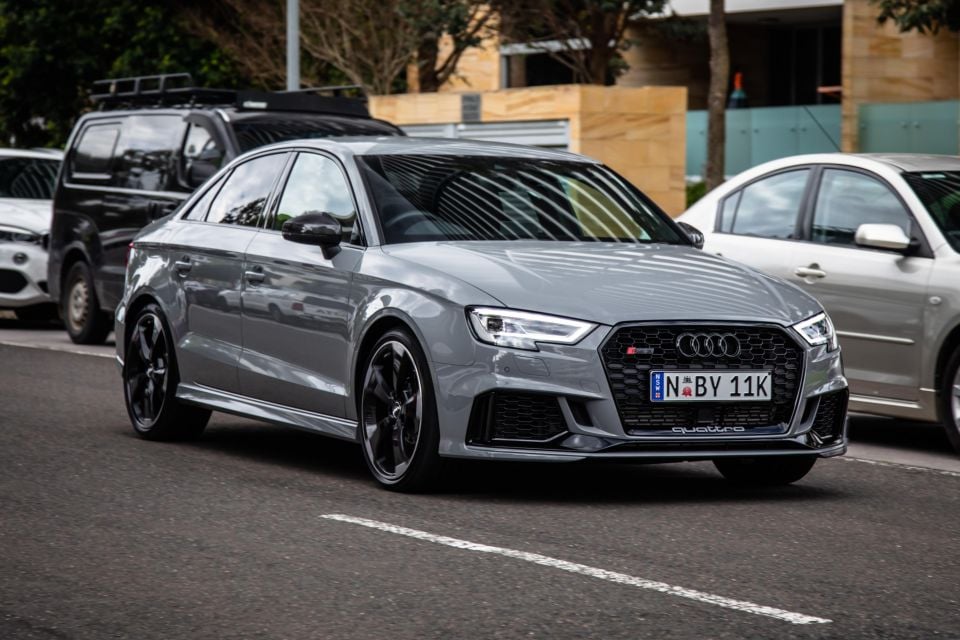
It’s a nice car to run to the shops in, unfatiguing and properly comfortable. Add sheer five-cylinder flexibility and it is, on balance, a more polished, satisfying and dignified daily driver than perhaps a base A3 35 TFSI is. It’s a proper Jekyll-Hyde.
The Carbon Edition’s wider front rubber (optional on the ‘standard’ model) does, in my past experience, pay dividends on a racetrack yet offer no shortcomings when touring. The RS3, like the Golf R, is inherently nose heavy in a manner that really only raises its head strung out on a circuit, and the extra front width of the Pirelli P Zeros add a bit of handy front-end purchase.
If you’re planning some off-street frivolity, the fatter hoops are near essential, though for point and squirt road driving the regular RS3’s slightly narrower rubber is just fine.
Like the rest of the infotainment system, the reversing camera quality is past its prime in viewing size and resolution if perfectly functional, and the sedan is easy to judge and park. The RS3 fits a cold engine warning system, too, that presents a conservative 4200rpm redline and only raises it up to around 5700rpm once the five-pot is up to temperature.
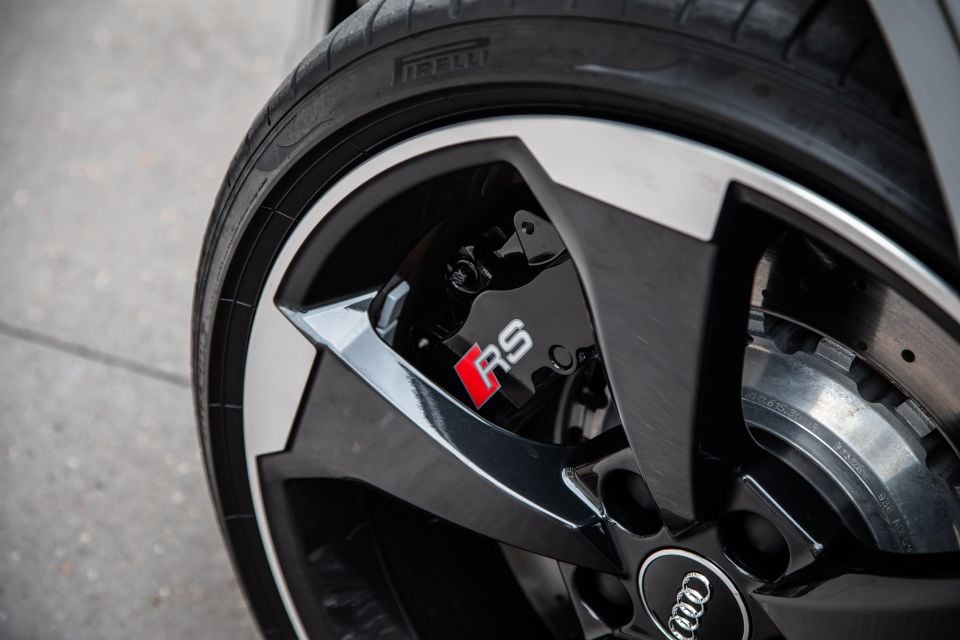
Audi’s usual three-year/unlimited warranty applies to the RS3 from its initial registration date or customer delivery, whichever comes first. That’s a bit slim when Mercedes-Benz offers two further years of warranty on its equally potent AMG A45 S.
A five-year servicing (75,000km) plan is offered at $3420, with servicing intervals occurring every 12 months and 15,000km.
As reported earlier, the turbo 2.5 five-cylinder requires a strict diet of 98RON fuel for not only happy operation but to prevent potentially steep repair bills to the petrol particulate filter mechanism.
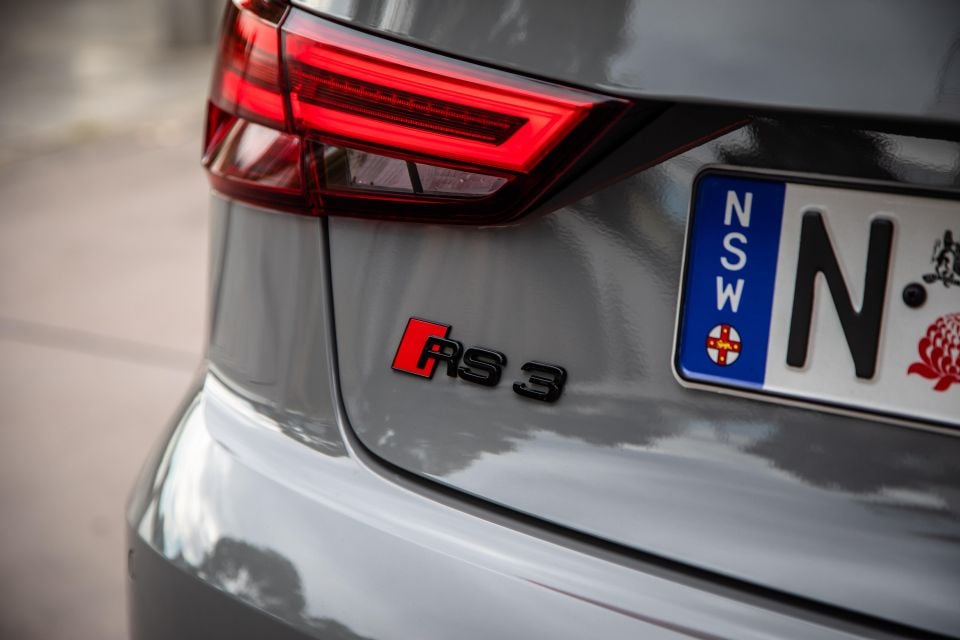
Where expert car reviews meet expert car buying – CarExpert gives you trusted advice, personalised service and real savings on your next new car.
The newly-fettled RS3 is a perfect example of a breed demonstrating its best at the tail-end of a generation’s lifecycle. And, while it’s not any hotter than versions prior, it’s certainly a nicer take that’s easier to live with without much penalty in performance and vibe. Obviously, the ageing DNA is becoming increasingly evident, particularly in infotainment.
It’s a shame, then, that it’s not a bit more compelling in the value for money department. There’s still plenty of life in this generation before a successor arrives and there are some extra goodies in compensation for a price rise, but in a few key areas it struggles to compete with much fresher, newer machinery from rival AMG, especially in the digital eye candy department.
This won’t deter the RS devotees who have been patiently waiting for what’s a hugely likeable RS3 to (re)surface in local showrooms after being sidelined in the WTLP sin bin.
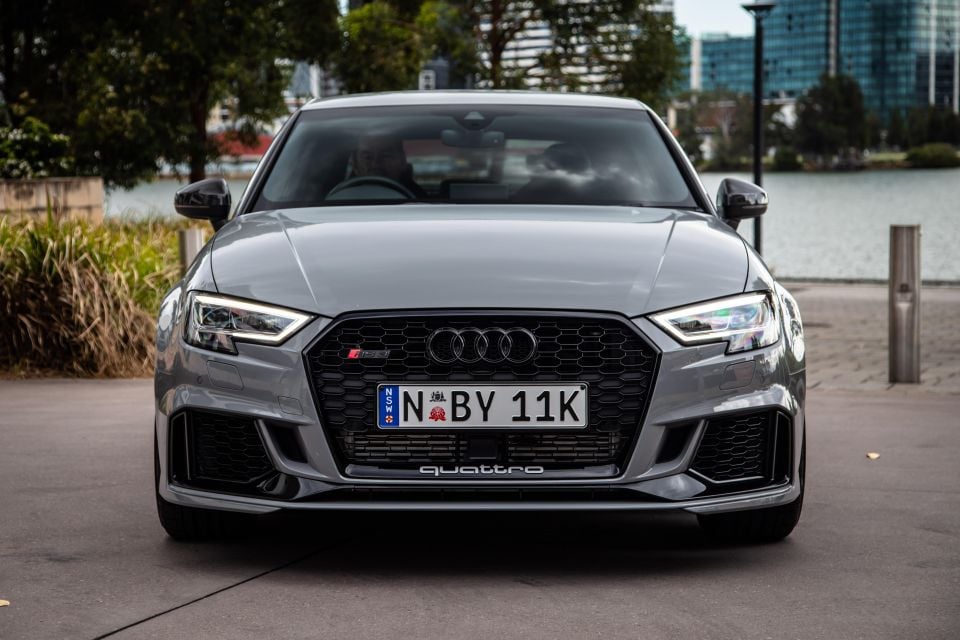
Click the images for the full gallery
MORE: Audi RS3 news and reviews MORE: Audi news and reviews
Where expert car reviews meet expert car buying – CarExpert gives you trusted advice, personalised service and real savings on your next new car.


Ben Zachariah
7 Hours Ago


CarExpert.com.au
15 Hours Ago


Damion Smy
1 Day Ago


Damion Smy
1 Day Ago


Damion Smy
1 Day Ago


Damion Smy
2 Days Ago